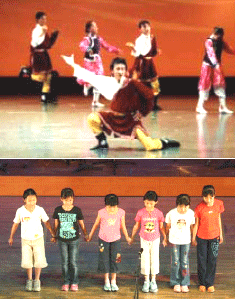UNESCO Children’s Performing Arts Festival of East Asia

The UNESCO Children’s Performing Arts Festival of East Asia (CPAF) gives young performers in East Asia an opportunity to get to know and communicate with each other through performing arts. Through the Festival, UNESCO responds to the challenge of moving from celebrating the diversity of national traditions to building pluralism by promoting the principle of "learning to live together." It is an exceptional opportunity to give a concrete illustration to the motto so dear to UNESCO: "Since wars begin in the minds of men, it is in the minds of men that the defences of peace must be constructed." (Preamble of UNESCO Constitution)
Objectives of the Festival
The Festival aims to foster the exchange and appreciation of diverse cultural traditions and is a way to promote the culture of peace, especially among young people. It seeks to have a positive impact on the ongoing efforts by countries in the East Asia sub-region to promote mutual understanding and encourage peaceful interactions among youth from a wide range of cultural backgrounds.
The Festival particularly seeks to:
- share the unique cultural and artistic traditions of China (including Hong Kong SAR and Macao SAR), DPR Korea, Japan, Mongolia, and the Republic of Korea among the children of the participating countries and regions;
- promote international friendship and cooperation among children and youth living in the East Asia sub-region;
- foster mutual understanding and respect through the exchange and performance of cultural arts by children’s performing groups.
History of the Festival
In the summer of 2000, Mr. Koichiro Matsuura, Director-General of UNESCO, paid his first official visit to China. The National Federation of UNESCO Associations in China arranged a children’s performance in honour of his visit. He enjoyed the performance so much that he suggested that the National Commissions for UNESCO organise an East Asian Children’s Performing Arts Festival (CPAF). The first such festival was held in Beijing in August 2001 to coincide with the first year of the United Nations International Decade for a Culture of Peace and Non-violence for the Children of the World (2001-2010).
Encouraged by the success of the first CPAF, the Director-General suggested organising the Festival as an annual cultural event for the region with different hosts from different countries. Thus, the second CPAF was successfully organised by the National Federation of UNESCO Associations in Japan in the seaside city of Fukuoka, Japan in August 2002, the third by the Korean National Commission for UNESCO in Suwon, Korea, in July 2004; and the fourth in Macao SAR, China, from 28 to 30 July 2005. The fifth CPAF was organized in Ulan-Bator, Mongolia from 27 to 29 July 2006. The sixth CPAF took place in Shenyang, China, from 2 to 4 August 2007.
For a summary of each Festival, consult the brochure (PDF).
Major achievements
In the past four years, the CPAF has given young performers in East Asia an unprecedented opportunity to carry out exchanges with face-to-face contact. Children from different countries and regions stayed and performed together in harmony despite the language and culture differences.
For the first time during the CPAF in Beijing (2001), participants from DPR Korea and the Republic of Korea exchanged gifts, shook hands and took pictures together to cherish and preserve the memory of the event. During the second CPAF in Fukuoka (2002), children from the Korean peninsula performed together on the same stage for the common cause of peace and mutual understanding. Beyond the strong political symbol, such acts of dialogue will have a long lasting impact on the children. This was a fulfilment of UNESCO’s role as a peace building UN agency, particularly in the minds of the children.
Widely used mass media such as television, radio, newspapers and Internet allowed dissemination of the Festival's activities beyond the participants and raised awareness of common cultural heritage shared by cultures of East Asia and the need for dialogue and mutual understanding for a durable peace in the region.
The CPAF aims at "safeguarding and promoting the rich diversity of cultures", as grounded in UNESCO Constitution and the UNESCO Universal Declaration on Cultural Diversity, adopted unanimously by the UNESCO General Conference in 2001. The Declaration acknowledges cultural diversity as the common heritage of humanity. It further promotes a vision of culture as inheritance and "blueprint giving our lives meaning," while defending a dynamic view in which culture is seen as a continuous, flexible and evolving process that adapts the received inheritance to new contexts.
The CPAF has managed to respond to the challenge of moving from celebrating the diversity of national traditions to building pluralism by promoting the principle of "learning to live together." This principle places citizens of the world on an equal level while respecting differences thereby combating prejudice, mistrust, fear and racism.


